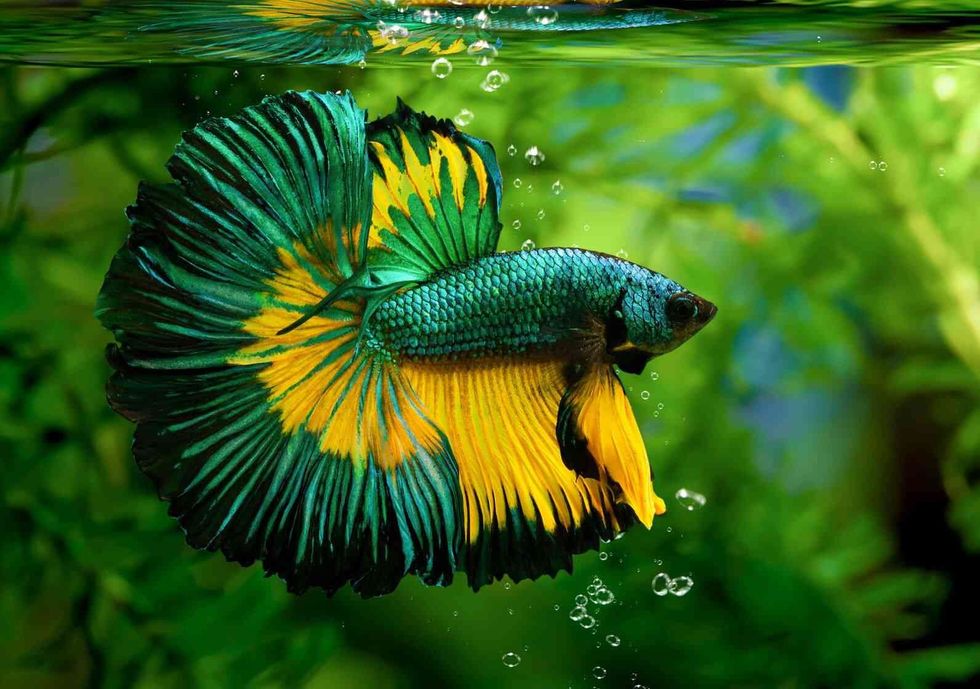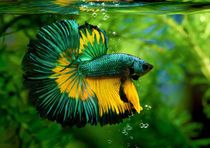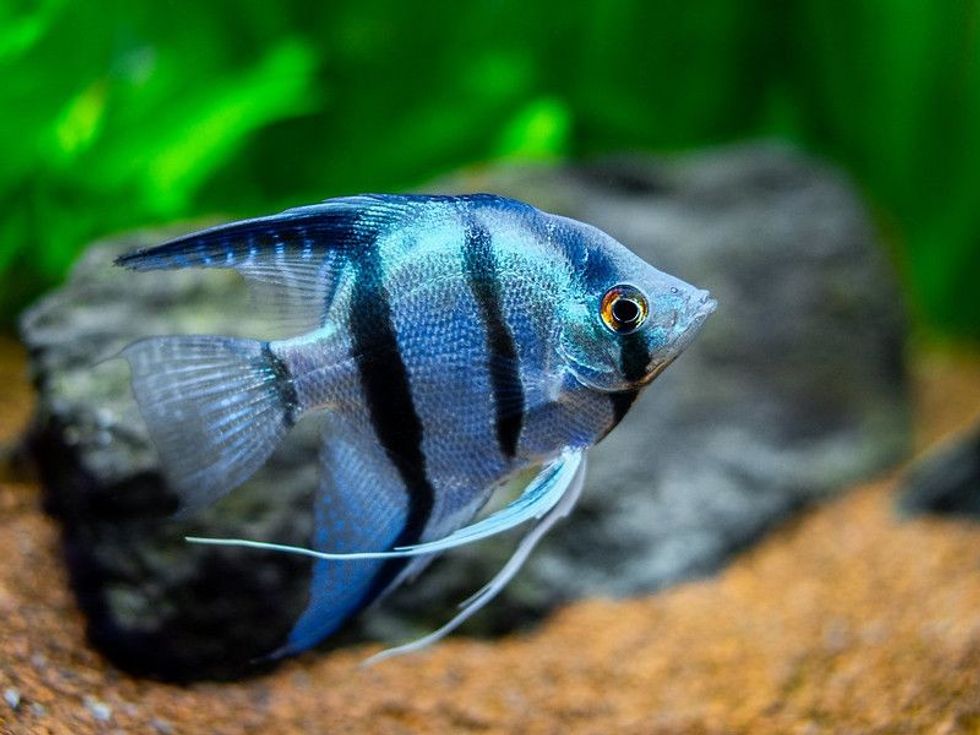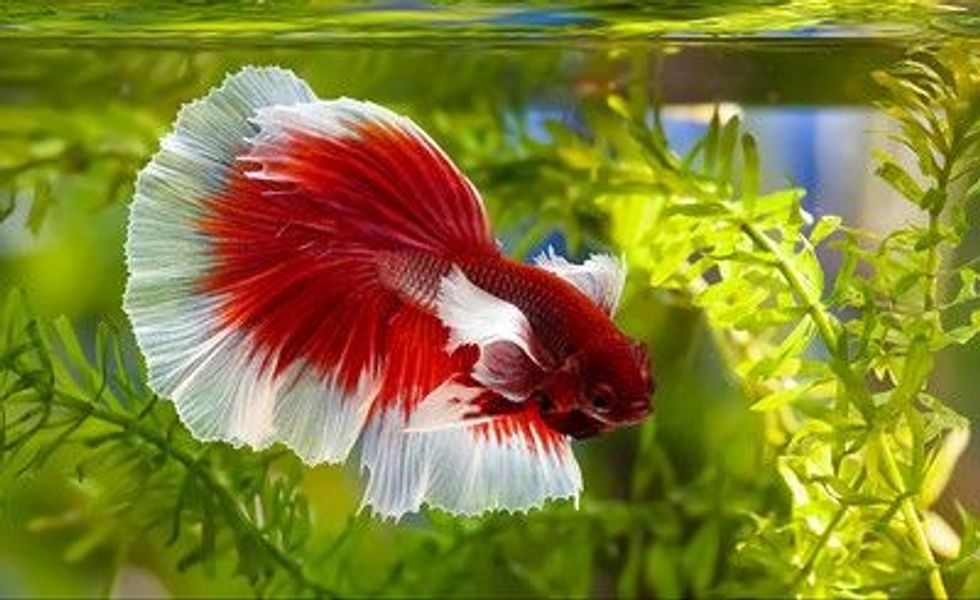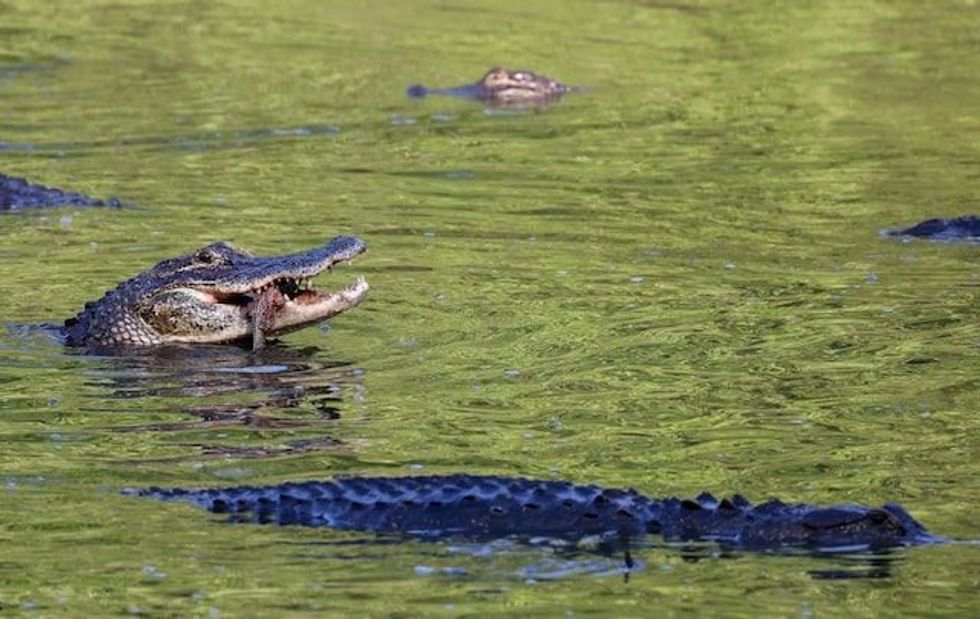Fish That Can Live With Bettas: Ideal Mates For Your Ferocious Fish

Content
- Can you keep betta fish with other fish?
- What fish can live with bettas and clean the tank?
- What bottom feeder fish can live with a betta?
- Factors That Make A Good Tank Mate For Your Betta Fish
- Tank Mates For Bettas Depending On Tank Size
- Do betta fish need tank mates to be happy?
- Can betta fish have tank mates and stay peaceful?
- Introducing Your Betta Fish to a Community
Betta fish are a type of tropical fish that are known for their entrancing colors and beautiful, fanning tails and fins.
They are also known for being aggressive, with their other name being Siamese fighting fish. Keeping this in mind, a common question that comes up for many betta pet owners is what fish make good betta fish tank mates?
Though betta fish are quite aggressive and territorial, they largely ignore fish that are mild-mannered and duller in comparison to them. They are top dwellers, which means that any organisms living in the middle and bottom sections of the tank are a good fit for them.
Keeping bottom dwellers also adds the bonus of natural tank cleansing, as they eat up any uneaten food which drifts to the bottom! To learn more about these ferocious fish, read on!
If you enjoy this article, do check out our other pages on fish eyes and fish that eat snails.
Can you keep betta fish with other fish?
Betta fish have a fierce reputation. They are known to be quite territorial and can be quite aggressive towards anyone who enters their territory.
However, they can indeed be kept together with the right types of fish. Like with humans, each betta fish has its own personality and may or may not be compatible with other fish in its tank.
Bettas are fish that must be kept solitarily i.e. not with other bettas.
Keeping two male betta fish together will end in disaster, as they will fight with each other. Other colorful or long-finned fish may also trigger your betta, as they may bear too much resemblance to other betta fish.
Female Betta fish have been housed together successfully for short periods of time, however, these instances have usually ended up in infighting as well.
When choosing ideal tank mates for your betta, a lot of factors come into play.
Fish that can survive in a similar environment as betta fish (i.e. slightly warm and acidic water conditions) are a must. The pH level preferred by bettas is usually between 6.8 and 7.4, and the water should ideally be between 75-80 F (24-26.6 C).
They also prefer their own space, and introducing other top-feeders is risky. Bottom feeders are your best bet in this situation, as they will go largely ignored by bettas as they tend to stay towards to top of the tank.
It is also necessary to have a large tank for your fish if you are planning on introducing tank mates.
Though bettas can thrive alone in tanks of 5 gal (22.7 l), anything smaller than 10 gal (44.5 l) is not advised when adding more fish, as Bettas need space of their own to be comfortable, or else they may end up being territorial.
It is advised to keep bettas on their own, as that is what they are most comfortable with. Adding tank mates adds no advantages for them, and it is usually only done for the benefit of the owner.
If you have a Betta fish and space constraints, then adding other fish to the existing tank may be the only option, otherwise, it is best to keep them alone.
What fish can live with bettas and clean the tank?
If housed in a community tank, then there will be a variety of bottom feeders as well as scavenger fish species which will help to clean up algae in the tank and feed on decomposing food. This helps to keep the tank naturally clean and prevent any bacteria or parasites from forming and causing harm to your fish.
Make sure that the fish you plan to keep are not aggressive either and are not fin nippers, or it can cause conflict among the inhabitants of your aquarium.
A few peaceful fish that make great betta fish tank mates are as follows.
Kuhli loaches. These eel-like fish are relatively small and make great betta fish tank mates as they have opposite schedules. Kuhli loaches are nocturnal in nature, meaning that they rarely come in contact with bettas, which are usually active during the day. This makes kuhli loach fish ideal roommates for even the most aggressive of betta fish.
Kuhli loach fish feed on sinking foods such as community pellets, frozen bloodworms, and blackworms. They may also clean up any food left uneaten by bettas, which reside at the top.
Though other loaches such as dojo loach and panda garra loach also make good choices. Avoid any loaches of the classification 'Botia', as they can grow quite large and may be aggressive. This includes the clown loach, skunk loach, and yoyo loach, to name a few.
Malaysian trumpet snails. Easier to house than the larger diurnal mystery snails (whose antennae might confuse your betta into thinking they are tasty worms), these snails are nocturnal in nature and spend their time burrowing in sandy substrate.
They usually feed on algae growing in the tank or uneaten food, which has sunk down to the gravel as well as other organic material. Their nocturnal nature means that they go largely unnoticed by top feeders like the betta, and they also help to naturally keep the tank clean.
Cory catfish. These schooling fish prefer to swim at the bottom of the tank.
Corydoras are available in a number of varieties, such as albino cory, pygmy corydoras, and panda cory varieties. They are adept at searching among the gravelly substrate for leftover food, but they must be provided with sinking food pellets as well to make sure that they do not go hungry.
Corydoras are pretty good at their job and will promptly eat up every last bit of uneaten food let in the tank.
Catfish. Most catfish are bottom feeders, and some of them even bury themselves among the sandy gravel floor, making them invisible to bettas!
Though catfish are considered bottom feeders due to their indifference to what type of food they eat, they are capable of swimming into other layers to search for food if they do not receive sufficient nutrition at the bottom of the tank.
They are adept at keeping too much algae from growing in the tank, as it is one of their primary food sources. Some small catfish you can house with your betta are the banjo catfish, Chinese and Siamese algae eaters, and Otocincluses.
Tetras. Neon tetras are schooling fish that make great pets for beginners, as they are easy to care for and quite entertaining.
Though black-neon tetras may be a bit flashy, they are very fast, which makes it difficult for bettas to catch them, even when in groups. A similar fish is the cardinal tetra, though these fish may grow slightly larger than the neon tetra.
Ember tetra. Ember tetras are also good fish to keep with bettas for the same reasons as the neon tetra.
Ember tetras are not picky eaters and are good at cleaning up leftover bits of fish food in the tank. Ember tetras are some of the best fish to keep with bettas due to their friendly, quick, and easygoing nature. Tetras also come in other beautiful colors such as gold, blue and red.
Harlequin rasboras. Harlequin rasboras are actually known to coexist with bettas in their wild habitat, which makes them a natural addition to this list. They are mild in nature and quite easygoing.
They are also quite colorful, which helps brighten up any tank! They are schooling fish, so they will have to be kept in groups of six fish or more. Do make sure that your minimum tank size, in this case, is more than 20 gal (90.9 l) to prevent overcrowding.
You can also house other organisms with your bettas, such as shrimp, snails, and frogs. However, these will require installing a proper filtration system and heater in your tank in order for them to thrive.
Snails are great companions for bettas as they go mostly ignored by them. They are also bottom feeders, meaning that they stay at the bottom of the tank and eat up all the leftover food particles, making them quite useful!
Some great snails you can consider adding to your aquarium are apple snails, turret snails, mystery snails, and nerite snails.
Shrimp. Even full-grown shrimp rarely grow larger than 2 in (5 cm).
However, a large enough tank is required so that they don't get snapped up by bettas! Shrimp are also adept algae eaters, crawling all over the tank and chipping away at any algae growing on the walls, hence keeping it at bay.
Red cherry shrimp, brine shrimp, Amano shrimp, and ghost shrimp are easily available and affordable options to buy in small groups for your tank.
African dwarf frogs. As African dwarf frogs are as different as you can get in appearance to bettas, there is little to no chance of them being attacked by the latter.
They usually stay at the bottom of the tank unless they require oxygen, in which case they will quickly jump to the surface once the coast is clear and gently sink back again. They are very low maintenance and produce little waste.
The only problem is trying to feed them with bettas in the way.
As bettas swim around the top layer, they may snap up all the food you are trying to feed your frog and may overeat in the process. This can be solved by feeding them through a pipette so that the food doesn't come in contact with bettas.
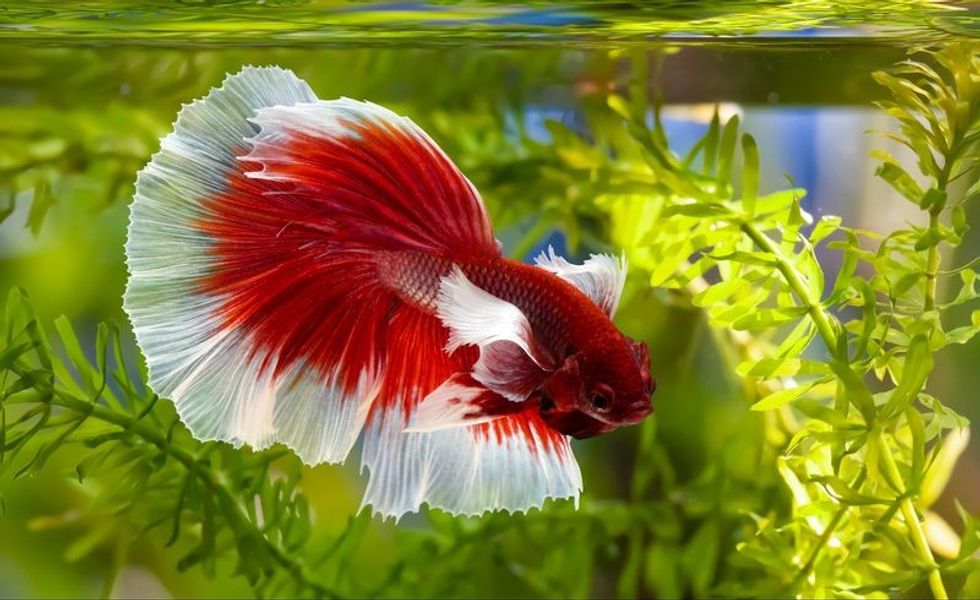
What bottom feeder fish can live with a betta?
The best tank mates to betta fish are bottom feeder fishes. They also clean your tank; talk about a win-win!
Many bottom-feeding fish, as well as other organisms such as shrimps and snails, are a great choice to house with bettas. Being bottom feeders, it is unlikely that they will make contact with territorial bettas, and an added bonus is that they help keep the tank naturally clean by scooping up any uneaten food.
This includes many types of loaches, catfish, and tetras.
Factors That Make A Good Tank Mate For Your Betta Fish
As betta fish can be quite picky with whom they share their space. There are a number of things to consider before letting another fish into your tank.
As betta fish are highly territorial, make sure not to keep more than one of them in the same tank at one time. Especially in the case of male betta fish, do not house them together as situations with two or more male betta fish together usually end in violence and bloodshed in the tank.
It is also recommended not to mix males and females in a single tank unless it is for breeding.
With female betta fish, the situation is slightly different. Female bettas have been observed to live together peacefully in groups, though in some cases, they may turn on each other and behave in a similar way to the males.
When it comes to these 'sororities', make sure that there is adequate vegetation available for the weaker females to have reliable hiding places, as they could be targeted by the alpha female (the leader of the pack).
Fights may occasionally break out if the alpha's position is challenged. To prevent dealing with this, it is advised just to keep female bettas alone as well, as they are equally territorial as males.
Similarly, make sure not to house them with brightly colored fish or any which have long, colorful tails similar to theirs. This may confuse bettas into thinking that there are other bettas in the tank and provoke them to attack.
If kept in a community tank, then there are a number of precautions that need to be taken in order to make sure that your betta doesn't cause chaos. Always house them in a tank with other fish who prefer the same water conditions as them. In this case, it is a slightly acidic environment with warm, flowing water.
As betta fish like their space, keep them with bottom or mid-tank dwellers so that they do not invade each other's spaces. Nocturnal creatures work well as well, as bettas are active during the day and sound asleep at night.
Bottom feeders also help to finish off whatever tidbits bettas leave uneaten, helping to keep the tank clean and ammonia levels stable.
Tank Mates For Bettas Depending On Tank Size
Betta fish are great if you have size constraints, as they do well in nano tanks (30 gal (136 l) of water or less).
However, in case you are housing them in tanks under five gal (22.7 l), then it is advised not to house them with other fish, as it may become too cramped for them and cause betta fish to turn aggressive.
In this case, you can add a few invertebrate bottom-feeders, such as shrimps and snails. The best types of these organisms to pair with aggressive betta fish are nerite snails, mystery snails, cherry shrimp, and ghost shrimp.
It is not advised to keep bettas in tanks smaller than 2.5 gal (11.36 l), so housing one in a 1.5 gal (6.8 l) tank is considered as mistreatment of the fish due to cramped surroundings.
Do betta fish need tank mates to be happy?
No, betta fish do not really need tank mates to be happy. Betta fish are curious fish, who enjoy swimming peacefully in their environment while observing the world outside of their tanks. If provided with the ideal water conditions, then your betta will live a long, peaceful life.
Do note that though bettas are one of the fish which can thrive in a 'nano tank', i.e. tanks holding 30 gal (136 l) of water or less, anything under 2.5 gal (11.3 l) is considered cramped and may harm your fish's health, shortening its lifespan.
In case you are keeping a group of female bettas, make sure that the tank is bigger than 10 gal (45.4 l).
Can betta fish have tank mates and stay peaceful?
Can bettas share their space with other tank mates and still stay peaceful? Read on to find out!
Yes, betta fish can indeed be kept with other fish and stay peaceful. However, these tankmates need to fit certain criteria so that they do not trigger the betta's aggressive side.
Bettas are known to be territorial towards others of their own kind (except towards the opposite sex when ready to mate). Keeping colorful, long-finned fish or any other top feeders may cause them to lash out.
Introducing Your Betta Fish to a Community
If trying to house betta with other fish, then the best way to do so is to add the betta to an existing aquarium rather than adding others to its tank.
Adding other fish to a betta's established territory may make it aggressive, whereas adding the betta to a tank already populated with other fish gives it no right to be aggressive.
However, there are chances that this operation may go awry, which is why it is advised to keep a five gal (22.7 l) tank handy to house the betta fish in case it doesn't cooperate with its new tank mates.
The steps to add your betta to a community are as follows.
First, quarantine your new betta fish for a few weeks and monitor its behavior periodically. Make sure that it has no parasites, diseases and is not behaving erratically.
Check the conditions of your tank and whether they are appropriate for your betta fish. If all your existing fish enjoy the same tank conditions, then this won't be much of a problem.
While introducing your betta into the tank, do not directly deposit it into the water. Put it in a small plastic bag or a small container to float on the top. This ensures that the betta slowly gets used to the temperature of the water and doesn't immediately attack anyone. This may take around one to two hours.
Keep slowly exchanging out the water from the bag for water from the aquarium. Add a 1/2 cup of water into the bag every four to five minutes, which will help slowly acclimatize the betta to the tank conditions. Once the bag is full, you can release your fish into the tank.
After successfully adding your betta to the tank, keep a close eye on its behavior and health. If it seems anti-social or has sustained damage to its scales or fins, it may be a sign of conflict among the fish.
Your betta may also eat other fish, which can be deduced from other fish going missing. If this happens, then shift your betta back to its individual tank, as this shows that it is best to house it alone.
Here at Kidadl, we have carefully created lots of interesting family-friendly facts for everyone to enjoy! If you liked our suggestions for 'Fish that can live with Bettas', then why not take a look at 'Do fish have teeth?' or 'Betta fish facts'.
We Want Your Photos!
More for You
See All
Bachelor of Arts specializing in Economics

Tanya ParkhiBachelor of Arts specializing in Economics
Tanya is a skilled content creator with a passion for writing and a love for exploring new cultures. With a degree in Economics from Fergusson College, Pune, India, Tanya worked on her writing skills by contributing to various editorials and publications. She has experience writing blogs, articles, and essays, covering a range of topics. Tanya's writing reflects her interest in travel and exploring local traditions. Her articles showcase her ability to engage readers and keep them interested.
Bachelor of Arts specializing in English, Bachelor of Education specializing in the Language Arts

Amatullah GulbargawalaBachelor of Arts specializing in English, Bachelor of Education specializing in the Language Arts
Amatullah is a passionate student pursuing a Bachelor of Arts and Bachelor of Education from Ashoka College of Education. With a keen interest in literature, she has excelled in elocution competitions and is an accomplished writer. She has completed courses like "History of English Language and Literature", "Introduction to Western Political Thought and Theory", and "Development of Soft Skills and Personality". In her free time, Amatullah enjoys reading books and writing poetry.
Disclaimer
1) Kidadl is independent and to make our service free to you the reader we are supported by advertising. We hope you love our recommendations for products and services! What we suggest is selected independently by the Kidadl team. If you purchase using the Buy Now button we may earn a small commission. This does not influence our choices. Prices are correct and items are available at the time the article was published but we cannot guarantee that on the time of reading. Please note that Kidadl is a participant in the Amazon Services LLC Associates Program, an affiliate advertising program designed to provide a means for sites to earn advertising fees by advertising and linking to Amazon. We also link to other websites, but are not responsible for their content.
2) At Kidadl, we strive to recommend the very best activities and events. We will always aim to give you accurate information at the date of publication - however, information does change, so it’s important you do your own research, double-check and make the decision that is right for your family. We recognise that not all activities and ideas are appropriate for all children and families or in all circumstances. Our recommended activities are based on age but these are a guide. We recommend that these ideas are used as inspiration, that ideas are undertaken with appropriate adult supervision, and that each adult uses their own discretion and knowledge of their children to consider the safety and suitability. Kidadl cannot accept liability for the execution of these ideas, and parental supervision is advised at all times, as safety is paramount. Anyone using the information provided by Kidadl does so at their own risk and we can not accept liability if things go wrong.
3) Because we are an educational resource, we have quotes and facts about a range of historical and modern figures. We do not endorse the actions of or rhetoric of all the people included in these collections, but we think they are important for growing minds to learn about under the guidance of parents or guardians.
